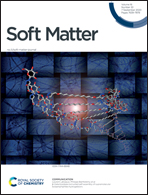Anisotropy versus fluctuations in the fractal self-assembly of gold nanoparticles†
Abstract
In a recent report, the fractal self-assembly of gold nanoparticles (AuNPs) having a directional feature was observed in the presence of visible light. Therein, the visible light, an external parameter, was suspected to be responsible for the directional feature. Herein, we investigate the intrinsic factors, the aspect size ratio p and the size a of AuNPs, in modulating the fractal characteristics of their self-assemblies. Through light scattering experiments and microscopic imaging, we demonstrate the transition of morphologies from fractal-like to cross-shaped in gold colloidal aggregates with particles having nearly spherical and ellipsoidal shapes, respectively. The transition indicates the competitive role of anisotropy and fluctuations in deciding the morphological characteristics of the aggregates. By taking noise-reduced diffusion-limited aggregation (NRDLA) as a model system, we address the shape and size induced noise of the particles in the colloidal systems which are prone to form fractal aggregates. We qualitatively relate the noise due to the particles having a distinct aspect size ratio p and size a with the noise reduction parameter m of NRDLA. The realistic nature of the experimental systems, where the particles of different p and a are present during the growth process, is incorporated by introducing the Gaussian noise reduction in diffusion-limited aggregation (DLA). The morphological phase transition in Gaussian noise reduced DLA is characterized, and its relevance for accounting the shape and size originated noise fluctuations during the fractal growth process is discussed. The results of the present study may be used for tailored applications of AuNPs in drug delivery, biomedicine, biosensing, and cancer nanotechnology.



 Please wait while we load your content...
Please wait while we load your content...